Extreme Weather Lawn Tips: Lawn Care During Harsh Conditions
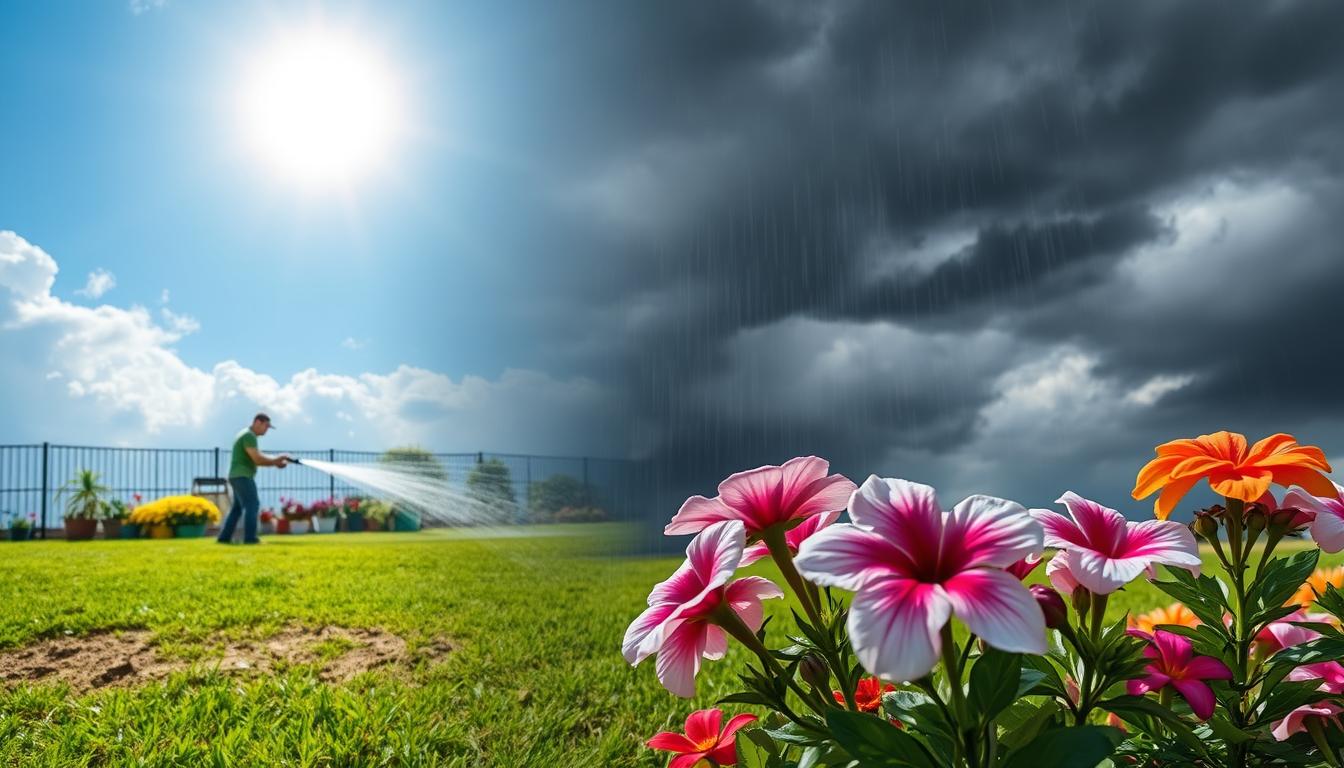
Living in Texas, we know the heat and drought can harm our lawns. Over 85% of the state has seen temperatures over 90°F for days. But don’t worry!
This guide will help you keep your lawn looking great, even in tough weather.
Make sure to use the right extreme weather lawn tips, like adjusting watering and mowing schedules, to help your lawn bounce back after the heat.
Key Takeaways
These extreme weather lawn tips can help your grass survive the heat and drought that often hits during the summer months.
- Adapt watering schedules and techniques to combat drought and heat stress
- Maintain optimal mowing height to support healthy grass growth
- Ensure proper soil aeration for better water and nutrient absorption
- Fertilize strategically to nourish grass without causing additional stress
- Monitor and treat lawn pests and diseases proactively
Follow these tips to have a lawn that’s tough and looks great, even in Texas’s hot summers. Let’s explore how to keep your lawn lush and green, no matter what the weather brings.
Watering Strategies for a Resilient Lawn
Proper watering is key for a healthy lawn in extreme heat. Water deeply but less often to promote strong roots and drought resistance. Aim for about one inch of water per week, adjusting for grass type, soil, and weather.
Watering in the early morning, before 10 AM, is best. This morning lawn watering helps the grass absorb water better. It also reduces evaporation, keeping the grass healthy in hot weather.
Adapt Watering Frequency and Timing
When it’s hot, focus on deep watering for drought tolerance. The University of New Hampshire Extension suggests watering between sunrise and 8 AM. This allows water to reach roots and cuts down on evaporation.
Install Smart Irrigation Systems
Smart irrigation systems can save water. They adjust watering based on weather and lawn needs. These systems help you reduce water usage by tailoring watering to your lawn’s specific needs.
“Watering the lawn before 10 a.m. can help grass retain moisture better, preventing wilting and browning in hot weather.”
Mowing Techniques to Combat Heat Stress
Summer heat can really hurt our lawns. To keep them healthy, we need to mow them right. We should keep the grass at a good height to protect it from the sun.
When dealing with extreme weather, it’s important to adjust your lawn care routine to keep it healthy and thriving.
Maintain Optimal Grass Height
Don’t cut your grass too short. It makes it hard for the grass to grow. It’s best to cut no more than one-third of the height at a time. The right height depends on the grass type, so ask a local expert.
- Taller grass blades shade the lawn, stopping weeds and helping the grass grow.
- Lawns only need one inch of water a week, including rain. Cutting the grass too short can make it need more water.
- Wait to mow if it’s over 90 degrees outside. It’s too stressful for the grass.
The best times to mow are mid-morning or late afternoon. This avoids drying out the grass too fast. Also, sharp mower blades help the grass heal faster.
Leaving grass clippings on the lawn is good. They act as a slow-release fertilizer. This helps the lawn grow strong, even in hot weather.
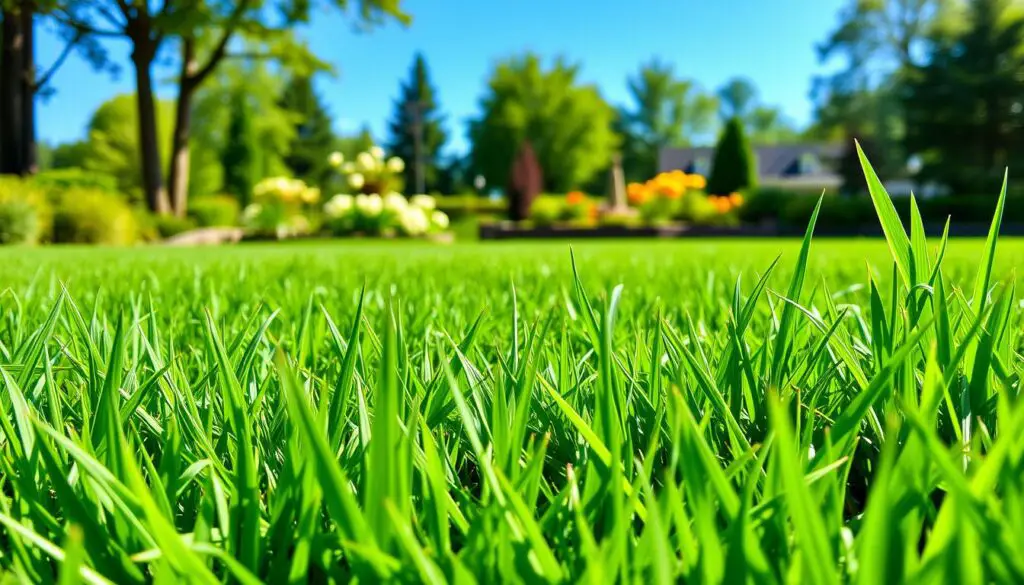
Ensure Proper Soil Aeration
Keeping your lawn healthy is more than just mowing and watering. A key step is soil aeration. Soil can get compacted from foot traffic, heavy rains, and settling. This blocks oxygen, nutrients, and water from reaching the grass roots.
This can make your lawn weak, with sparse growth and poor water absorption. To fix this, aerate your lawn when it’s growing. For warm-season grasses like Bermuda, zoysia, and St. Augustine, the best time is late spring to early summer.
Doing lawn aeration yourself is possible, but hiring a professional lawn service can be better. They have the right tools and know-how to aerate your lawn well. This helps your grass thrive in the summer.
| Grass Type | Best Time for Aeration |
|---|---|
| Cool-season Grasses (Kentucky bluegrass, tall fescue, perennial ryegrass) | Early August or October |
| Warm-season Grasses (Bermuda, zoysia, St. Augustine) | Early August through October |
The best time to aerate lawn varies by grass type. Knowing your lawn’s needs and using professional lawn aeration services helps. This way, your grass stays healthy and green all summer.
“Aeration is a game-changer for lawns, unlocking the soil and allowing vital resources to reach the roots. It’s a must-do for any homeowner who wants a thriving, vibrant outdoor space.”
Fertilize for Nourished Grass Growth
By following some simple extreme weather lawn tips, you can ensure your lawn stays green and strong, even in tough conditions.
Keeping your lawn lush and healthy in summer needs smart fertilizing. It might seem odd to feed your grass in the hot, dry season. But, giving it the right nutrients can make it stronger and more resilient. The trick is to pick the best fertilizer and apply it at the right time.
Use Slow-Release Fertilizers
For the best summer lawn care, slow-release fertilizers are a top choice. They give your grass a steady flow of nutrients for a long time. This method avoids burning or over-fertilizing, common with quick-release products. Slow-release fertilizers are perfect for summer, when the grass faces more stress.
Consider Compost Top-Dressing
Compost top-dressing is a green alternative to regular fertilizers. It’s a thin layer of compost that feeds your lawn with organic matter and nutrients. It also helps keep the soil moist and improves its structure. This natural method is good for your lawn in the summer.
| Nutrient | Role in Lawn Health | Ideal Ratio |
|---|---|---|
| Nitrogen (N) | Promotes green growth and color | 20% |
| Phosphorus (P) | Supports root development and overall plant health | 20% |
| Potassium (K) | Enhances drought and disease resistance | 10% |
By using these methods in your summer lawn care, you can make sure your grass gets the nutrients it needs. This way, it can thrive even in the hottest summer months.
Monitor and Control Lawn Pests
Keeping your lawn healthy in Texas’s hot summers is tough. Common pests like grubs, chinch bugs, armyworms, and sod webworms can harm your grass. They cause discoloration, dead patches, and weaken the turf. It’s crucial to watch your lawn for pest signs to protect it.
Birds visiting your lawn often mean pests are around. You might see discolored or wilting grass. These signs mean it’s time to act and use effective pest control.
| Pest | Life Cycle | Damage Potential |
|---|---|---|
| White Grubs | 1-year life cycle, burrow into soil for winter | Consume grass roots, causing dead patches |
| Chinch Bugs | 2 generations per year, hatch in 20-30 days | Suck plant juices, causing grass to turn yellow and die |
| Armyworms | 2-3 generations per year, hatch within a week | Chew on grass blades, leading to unsightly damage |
| Sod Webworms | 2-3 generations per year, hatch in 7 days | Burrow into soil and feed on grass, creating dead spots |
To manage pests in Texas, create a detailed pest control plan. This might include prevention, natural methods, and chemical treatments. Always talk to a local pest control expert to find the best solution for your lawn.
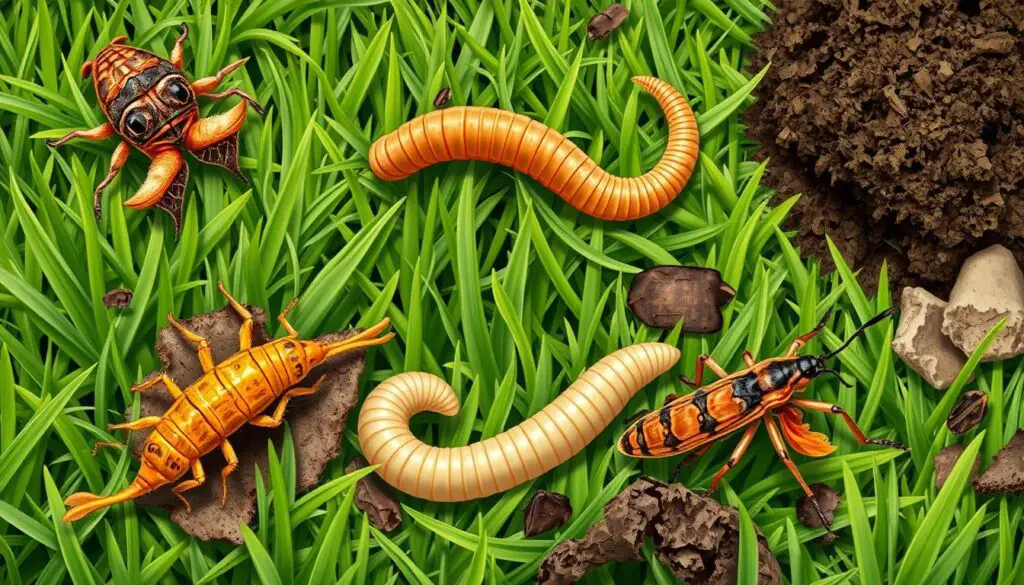
By watching for pest signs and acting early, you can keep your lawn healthy. With the right pest control, your lawn will thrive in Texas’s climate. You’ll have a beautiful green space in your backyard.
Identify and Treat Lawn Diseases
As a Texas homeowner, knowing about common lawn diseases is key to a lush, healthy yard. The brown patch fungus is a big problem here, thanks to our hot, humid summers. If not treated, it can damage your grass, leaving brown or yellow spots.
Look out for irregularly shaped, discolored turf areas. Regular lawn checks are important. If you see signs of disease, get a pro to diagnose and treat it.
Prevent Disease Through Maintenance
Preventive lawn care is vital. A balanced watering schedule and avoiding too much fertilizer help. Keeping your lawn equipment clean also reduces disease risk. These steps can keep your Texas lawn healthy and strong.
| Common Lawn Diseases in Texas | Affected Grass Types |
|---|---|
| Brown Patch | Warm-season grasses like Bermuda, Zoysia, and St. Augustine |
| Gray Leaf Spot | Warm-season grasses such as Bermuda, Zoysia, and St. Augustine |
| Pythium Blight | All turfgrass types, including lawns, golf courses, and sports fields |
| Summer Patch | Cool-season grasses like Kentucky Bluegrass, Tall Fescue, and Fine Fescue |
“Proper lawn maintenance is the best defense against diseases. By following a proactive approach, you can help keep your Texas lawn healthy and vibrant throughout the year.”
Create a Seasonal Lawn Care Calendar
To keep your lawn healthy and green, you need a plan. A lawn care calendar helps you do this. It lists important tasks like watering, mowing, and fertilizing.
Warm-season grasses grow best from May to mid-September. Cool-season grasses do well from December to early February, unless it’s too cold.
Timing is key for a great lawn. For example, use weed control in mid-February. Aerate in March to improve soil. Topdress in April for a smooth lawn.
| Lawn Care Task | Optimal Timing |
|---|---|
| Pre-emergent herbicide application | Mid-February |
| Core aeration | March |
| Topdressing | April |
| Insecticide and fungicide application | April |
| Soil fertilization | Mid-April (when soil temp reaches 55°F) |
| Mowing start | March/April (when temp reaches 50°F and grass height is 2″-2.5″) |
With a lawn care calendar, your lawn stays healthy all year. This plan supports your grass’s natural growth. Your lawn will be lush and vibrant, ready for any season.
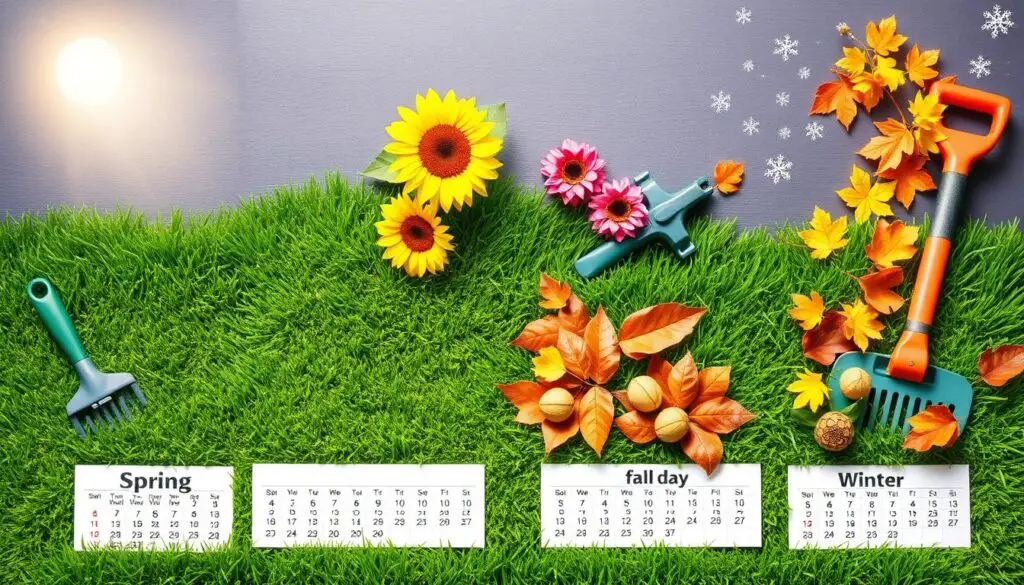
Choose Heat-Tolerant Grass Cultivars
Keeping your lawn lush in Texas’s hot summer is all about picking the right grass. Warm-season grasses like Bermuda grass, St. Augustine grass, and Zoysia are top picks. They handle heat and drought well. Choosing these best grass types for Texas helps your yard thrive in the heat.
Bermuda grass is known for its heat and drought-resistant grass varieties. Celebration, GN1, Grimes EXP, TexTurf, TifSport, and Tifway 419 are some of the best. St. Augustine grass’s Floratam variety is also great for hot areas. Zoysia grass, with El Toro, Empire, Jamur, and Palisades, is another heat-tolerant option.
When picking grass, think about shade, traffic, and upkeep. A local lawn care expert can guide you. They help ensure your lawn stays green and healthy, even in the heat.
| Grass Type | Heat Tolerance | Drought Tolerance | Maintenance Level |
|---|---|---|---|
| Bermuda Grass | High | High | Moderate |
| St. Augustine Grass | High | Moderate | High |
| Zoysia Grass | High | High | Moderate |
| Buffalo Grass | Moderate | High | Low |
| Centipede Grass | Moderate | Moderate | Low |
By picking the right heat and drought-resistant grass varieties for your Texas lawn, you can have a beautiful outdoor space. It will stand up to extreme weather and impress your neighbors.
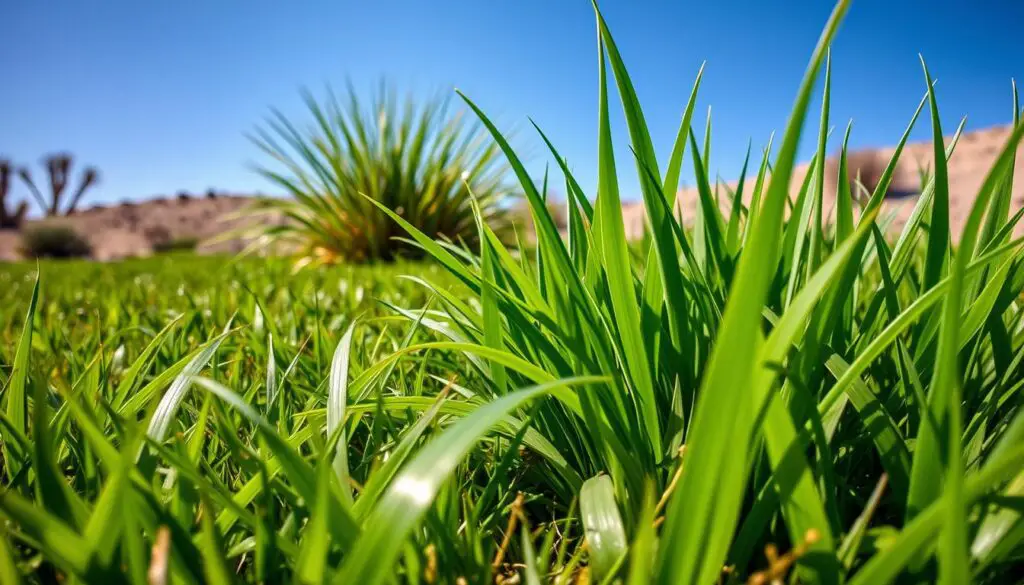
Incorporate Drought-Resistant Landscaping
Extreme weather conditions are a big challenge. It’s important to use drought-resistant landscaping in our gardens and outdoor spaces. Xeriscaping, a water-efficient method, can help fight the Texas heat and save water.
Xeriscaping and Hardscaping
Xeriscaping means choosing plants that don’t need much water, improving soil, and using mulch to cut down on evaporation. By grouping plants that need the same amount of water, you can make watering easier. Also, adding hardscape elements like patios and decks can reduce the need for lawn care and water.
- Drought-tolerant plants like ornamental grasses, succulents, and native species thrive in dry conditions and require minimal watering.
- Ground cover and mulch help retain soil moisture, suppress weeds, and enhance soil health.
- Drip irrigation systems deliver water directly to plant roots, reducing evaporation and increasing water efficiency.
- Rain harvesting systems can supplement water supply during droughts by collecting rainwater.
- Hardscaping features like porous pavement and gravel can reduce runoff and water pooling in outdoor spaces.
By using xeriscaping and hardscaping techniques, you can make a beautiful, water-saving landscape. This landscape will not only survive the Texas heat but also add beauty and value to your property.
Watering Adjustments During Heat Waves
Summer heat makes it key to adjust your lawn watering. When it’s over 85°F for days, lawns like Kentucky Bluegrass get stressed. Water deeply and often to keep your lawn healthy, aiming for 2 inches of water a week.
Morning Watering and Catchcan Method
Watering in the early morning, from 4-8 AM, is best. It lets the grass soak up water before the sun gets too hot. The “catchcan” method helps water just right. It uses cans to measure water and figure out how long to water.
| Lawn Type | Watering Needs |
|---|---|
| Cool-Season Turf (e.g., Kentucky Bluegrass) | Requires about 2 inches of water per week during heat waves |
| Warm-Season Turf (e.g., Bermuda, St. Augustine) | Requires more frequent watering to prevent dormancy, with a recommendation of twice-daily watering during drought conditions |
Changing your watering ways and using the catchcan method can keep your lawn looking great, even in the hottest times.
Lawn Care Extreme Weather
Keeping your lawn healthy in extreme weather, like Texas summers, needs a good plan. Use smart lawn care to keep your lawn green and strong, even when the weather is tough.
Choosing heat-tolerant grass is key. Native grasses like Kentucky Blue or Rye are good for hot and dry weather. Also, pick grasses that fit your lawn’s height.
Soil health is also important. Adding compost or peat moss helps with drainage and nutrients. Test your soil often to keep it healthy.
- Use drainage solutions like French drains to avoid waterlogging.
- Aerate your soil to help air and water reach the roots.
Water your lawn in the early morning or late afternoon to save water. Also, create shaded areas to protect your lawn from the sun.
Change your lawn care as the seasons do. Use winter fertilizer to help your lawn through cold months. Don’t mow when it’s cold to avoid damage.
| Lawn Care Strategies for Extreme Weather | Benefits |
|---|---|
| Choose heat-tolerant grass cultivars | Improved drought resistance and durability |
| Enhance soil health with compost and aeration | Better drainage, nutrient availability, and root growth |
| Adjust watering practices and create shaded areas | Minimize evaporation and protect from heat stress |
| Implement seasonal care, including winter fertilization | Prepare the lawn for changes in weather conditions |
By using these lawn resilience strategies, you can have a beautiful lawn all year. Get advice from local experts to make your lawn thrive in your area.
“Maintaining a healthy lawn in extreme weather requires proactive planning and adaptability. By combining the right grass selection, soil management, and seasonal care, homeowners can create a resilient outdoor oasis that withstands nature’s harshest conditions.”
Mowing Height and Traffic Limitations
When it’s hot outside, changing how you mow your lawn is key. Raising the mower height helps shade the grass and cuts down on water loss. For cool-season grasses like Kentucky bluegrass and perennial ryegrass, aim for a height of about 3 inches. This keeps the soil cool and the roots healthy.
Try not to mow when it’s hottest. Mowing in the evening lets the grass recover better. Also, reduce foot traffic to prevent damage from heat tracking. If needed, make paths for walking and limit mower use during the hottest times.
These steps can help your lawn stay strong during hot weather. Keep an eye on your grass and adjust as needed for its health.
Research shows that mowing grass at the right height is vital for its health and resilience in extreme weather.
To get the mowing height right, measure from the mower blades to the ground. Don’t just look at the numbers on the mower. This ensures you cut your grass at the best height for it.
By using these mowing and traffic tips, your lawn can handle the heat better. It will stay green and healthy all summer.
Time Treatments by Temperature
As a homeowner, I know how crucial a healthy lawn is. But using herbicides or fertilizers in hot weather can be risky. Only trained professionals should handle these treatments. They apply them when it’s cooler, ensuring they work best.
Trying to do it myself in the heat can cause problems. It might lead to herbicide drifting or damage to my lawn. That’s why I always talk to a lawn care expert in extreme weather. They guide me on the best way to apply treatments safely and effectively.
By teaming up with lawn care pros and timing treatments right, my lawn gets what it needs. This approach keeps my lawn looking great, even in tough weather. It’s a smart move that pays off in the long run.
FAQ
How can I maintain a healthy lawn during the intense Texas summer heat?
What are the best watering strategies for a resilient lawn in the summer?
How should I adjust my mowing practices to combat heat stress?
Why is soil aeration important for a healthy lawn in the summer?
How can I ensure proper nourishment for my lawn during the summer?
How do I identify and address lawn pests during the Texas summer?
What can I do to prevent and treat lawn diseases in the summer?
How can I create a comprehensive lawn care calendar to ensure year-round resilience?
What are the best grass cultivars for the Texas summer heat?
How can I incorporate drought-resistant landscaping techniques to combat the Texas heat?
How should I adjust my lawn watering during extreme heat waves?
What should I consider when mowing and limiting foot traffic during a heat wave?
When should I apply lawn treatments, such as herbicides or fertilizers, during extreme heat?
Source Links
- https://portageturf.com/blog/lawn-care-steps-to-protect-your-grass-during-extreme-heat/
- https://www.gardeningknowhow.com/lawn-care/heat-stressed-lawn-care
- https://thelawncarenut.com/blogs/news/helping-your-lawn-when-temps-are-over-85?srsltid=AfmBOopISjmUF2kCiONKjvaWkzg_xJlO1pmqgxiZ4HqRpGAUx8GWsqbr
- https://www.mainelygrass.com/blog/5-essential-lawn-care-tips-for-surviving-a-heat-wave
- https://luvalawn.com/maximize-your-lawns-resilience-summer-care-tips-for-a-healthy-yard/
- https://www.realsimple.com/how-to-protect-your-lawn-from-extreme-weather-8694848
- https://www.yardcare.com/how-to-maintain-grass-in-extreme-heat/
- https://www.mainelygrass.com/blog/beat-the-heat-how-to-maintain-your-lawn-in-the-summer
- https://kappslawn.com/the-importance-of-timely-aeration-dont-wait-until-its-too-late/
- https://ekglawn.com/2024/08/05/why-your-lawn-needs-aeration/
- https://theturfgrassgroup.com/turf-maintenance/lawn-care-with-beer-and-soap-these-are-the-top-nutrients-grass-needs-to-grow/
- https://www.abralawn.com/blog/the-importance-of-fertilization-for-a-healthy-lawn/
- https://thelawncarenut.com/blogs/news/helping-your-lawn-when-temps-are-over-85?srsltid=AfmBOopsWH4IGOEtdSIwItWCgOGVEUm94jJK4C1pPeinDwK-sHmoRsMr
- https://www.gardentech.com/blog/pest-id-and-prevention/how-to-detect-and-treat-common-lawn-pests
- https://precisionlawnandlandscape.com/the-importance-of-lawn-insect-control/
- https://weedman.com/blog/common-lawn-diseases
- https://fortsmithlandscaping.com/blog/lawn-diseases-in-nc/
- https://golfcourselawn.store/pages/365-day-lawn-care-schedule?srsltid=AfmBOooDp0j10sBmLGOB8R6T5txwXtBpBILhhkzWio8uS_nKFUPkDFRp
- https://scotts.com/en-us/lawn-care-101/your-seasonal-guide-to-a-lush-lawn.html
- https://www.groundsguys.com/blog/2016/july/which-kinds-of-grasses-survive-the-heat-the-best/
- https://gcmonline.com/course/environment/news/turfgrass-heat-stress-tolerance
- https://www.pennington.com/all-products/grass-seed/resources/recommended-grasses-for-regional-climates
- https://lawnlove.com/blog/drought-tolerant-landscaping-ideas/
- https://attentive.ai/blog/the-impact-of-climate-change-on-landscape
- https://www.cllandscape.com/climate-wise-landscaping-tailoring-your-garden-to-thrive-in-any-weather/
- https://thelawncarenut.com/blogs/news/helping-your-lawn-when-temps-are-over-85?srsltid=AfmBOorzcM3LU3aJHPhZO140GIu_ha42VQGmQQ0Z8jwipccNbAhYcGSv
- https://www.tomsguide.com/how-to/how-to-water-your-lawn-in-a-heat-wave
- https://lawnlove.com/blog/keeping-your-grass-alive-in-a-heat-wave/
- https://www.coryslawnservice.com/corys-lawn-service/protecting-your-lawn-from-extreme-weather
- https://sites.utexas.edu/discovery/2024/07/17/how-weather-patterns-affect-lawn-health/
- https://thelawncarenut.com/blogs/news/helping-your-lawn-when-temps-are-over-85?srsltid=AfmBOor5Ie04YgFS_yme-syyfqGyDVonsaLi_6DgfHixGdlqUkiuGRER
- https://www.greenviewfertilizer.com/articles/why-you-shouldn-t-mow-in-high-heat
- https://lawnhub.com.au/blogs/news/preparing-your-lawn-for-extreme-weather?srsltid=AfmBOoqJfPOk1M_uATnoQbxKslN-8aYLbANZx_OCf3gIQd2ZorLviqrK
- https://www.oasisturf.com/blog/the-truth-on-how-rain-heat-and-cold-affect-lawn-care-results
- https://www.lawnstarter.com/blog/lawn-care-2/seasonal-lawn-maintenance-guide-in-atlanta-ga/

